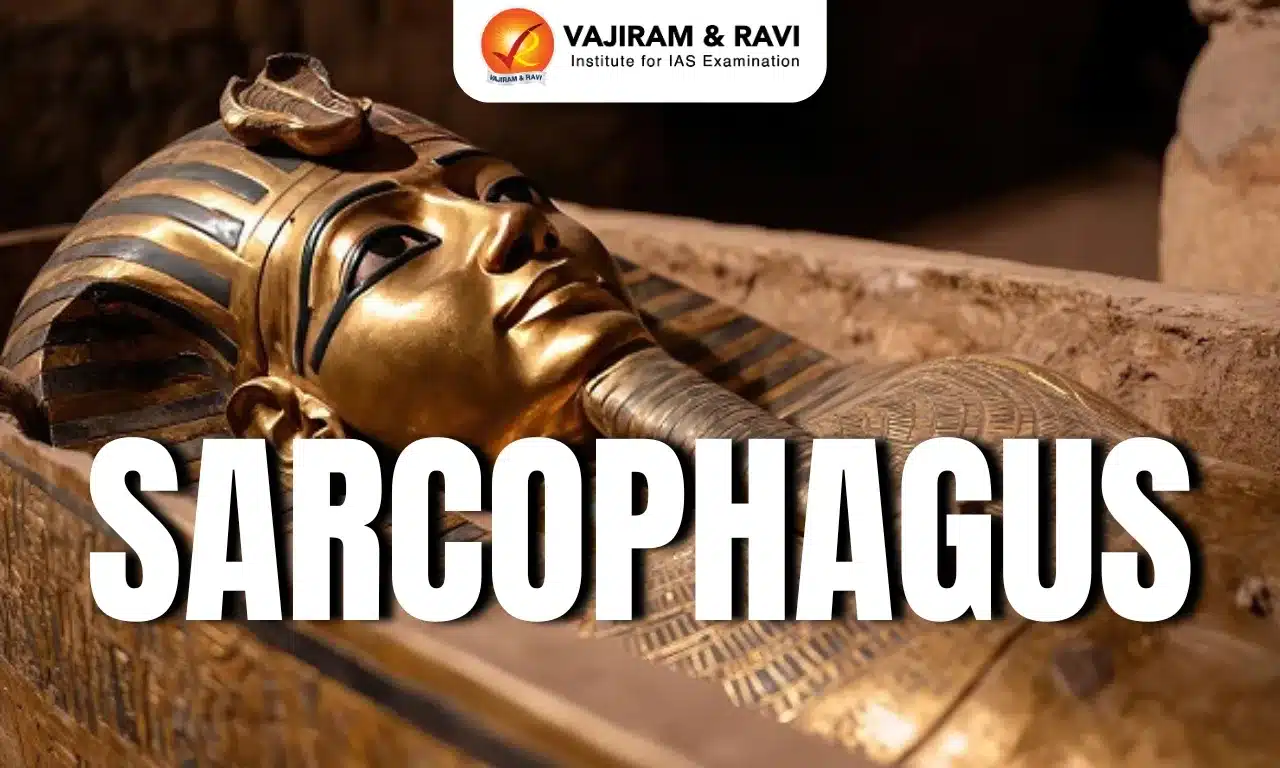Sarcophagus Latest News
The first-ever scientific dating of a sarcophagus (terracotta coffin) found recently in Kilnamandi village in Tiruvannamalai district indicates that Tamil Nadu might have had trade contact with the north during the time of the Late Harappan civilisation.
About Sarcophagus
- Used to bury leaders and wealthy residents in ancient Egypt, Rome, and Greece, a sarcophagus is a coffin or a container to hold a coffin.
- They were intended to be displayed above ground, but they were sometimes entombed or placed in burial chambers.
- The word “sarcophagus” comes from ancient Greek words. Sarx means “flesh,” and phagein means “to eat.” So, “sarcophagus” literally means “flesh-eating.”
- This name came from a special type of limestone that people believed could help bodies decompose quickly.
- First used in Ancient Egypt and Ancient Greece, the sarcophagus gradually became popular throughout the ancient world.
- The earliest stone sarcophagi were used by Egyptian pharaohs of the 3rd dynasty, which reigned from about 2686 to 2613 B.C.E.
- It carried over through the later years of European society, often used for high status members of the clergy, government, or aristocracy.
- Features:
- They differ in detail from one culture to another.
- They are almost always made of stone, limestone being the most popular, but sometimes of granite, sandstone, or marble.
- Sarcophagi were elaborately decorated with carvings, images, and writing, usually including the name of the person who died.
- Archaeological Significance:
- Sarcophagi are important artifacts for archaeologists and historians because they provide insights into the art, culture, and beliefs of the societies that created them.
- The carvings and inscriptions on sarcophagi often contain valuable historical information.
- Example: The most famous Egyptian sarcophagus is perhaps the golden sarcophagus of King Tutankhamun.
Source: TOI
Last updated on December, 2025
→ Check out the latest UPSC Syllabus 2026 here.
→ Join Vajiram & Ravi’s Interview Guidance Programme for expert help to crack your final UPSC stage.
→ UPSC Mains Result 2025 is now out.
→ UPSC Notification 2026 is scheduled to be released on January 14, 2026.
→ UPSC Calendar 2026 is released on 15th May, 2025.
→ The UPSC Vacancy 2025 were released 1129, out of which 979 were for UPSC CSE and remaining 150 are for UPSC IFoS.
→ UPSC Prelims 2026 will be conducted on 24th May, 2026 & UPSC Mains 2026 will be conducted on 21st August 2026.
→ The UPSC Selection Process is of 3 stages-Prelims, Mains and Interview.
→ UPSC Result 2024 is released with latest UPSC Marksheet 2024. Check Now!
→ UPSC Prelims Result 2025 is out now for the CSE held on 25 May 2025.
→ UPSC Toppers List 2024 is released now. Shakti Dubey is UPSC AIR 1 2024 Topper.
→ UPSC Prelims Question Paper 2025 and Unofficial Prelims Answer Key 2025 are available now.
→ UPSC Mains Question Paper 2025 is out for Essay, GS 1, 2, 3 & GS 4.
→ UPSC Mains Indian Language Question Paper 2025 is now out.
→ UPSC Mains Optional Question Paper 2025 is now out.
→ Also check Best IAS Coaching in Delhi
Sarcophagus FAQs
Q1. What is a Sarcophagus?+
Q2. Which ancient civilization first used stone sarcophagi?+
Q3. Where were sarcophagi typically placed?+
Q4. Besides Egypt, which other ancient civilizations commonly used sarcophagi?+
Tags: prelims pointers sarcophagus upsc current affairs upsc prelims current affairs

















